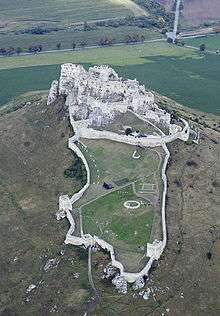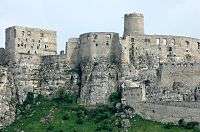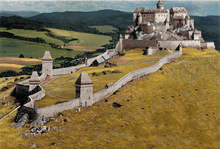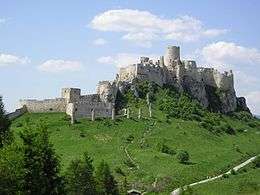Spiš Castle
The ruins of Spiš Castle (Slovak: Spišský hrad, ![]()
| Spiš Castle | |
|---|---|
Spišský hrad | |
| Spišská Nová Ves, Spiš | |
 Spiš Castle | |
 Spiš Castle | |
| Coordinates | 49°00′02″N 20°46′06″E |
| Type | Castle |
| Site history | |
| Built | 12th century |
| Materials | Masonry |
History


Spiš Castle was built in the 12th century on the site of an earlier castle. It was the political, administrative, economic and cultural center of Szepes County[1] of the Kingdom of Hungary. Before 1464, it was owned by the kings of Hungary, afterward (until 1528) by the Zápolya family, the Thurzó family (1531–1635), the Csáky family (1638–1945), and (since 1945) by the state of Czechoslovakia then Slovakia.
Originally a Romanesque stone castle with fortifications, a two-story Romanesque palace and a three-nave Romanesque-Gothic basilica were constructed by the second half of the 13th century. A second extramural settlement was built in the 14th century, by which the castle area was doubled. The castle was completely rebuilt in the 15th century; the castle walls were heightened and a third extramural settlement was constructed. A late Gothic chapel was added around 1470. The Zápolya clan performed late Gothic transformations, which made the upper castle into a comfortable family residence, typical of late Renaissance residences of the 16th and 17th centuries. The last owners of the Spiš Castle, the Csáky family, abandoned the castle in the early 18th century because they considered it too uncomfortable to live in. They moved to the newly built nearby village castles/palaces in Hodkovce near Žehra and Spišský Hrhov.

Decline and reconstruction
In 1780, the castle was destroyed in a fire. The cause of the blaze is unknown, but there are a few theories. One is that the Csáky family purposely burned it down to reduce taxes as at the time additional taxes applied to roofed buildings. Another is that it was struck by lightning, which started the fire. A third is that some soldiers in the castle were making moonshine and in the process accidentally started the fire. Whatever the case, after the fire, the castle was no longer occupied and began to fall into disrepair.[2]
The castle was partly reconstructed in the second half of the 20th century, and extensive archaeological research was carried out on the site. The reconstructed sections house displays of the Spiš Museum, and artifacts such as torture devices formerly used in the castle.
Image gallery
 Overall view of the castle
Overall view of the castle- Lower fortifications
- Wall, and tower
 View from east
View from east
References
External links
| Wikimedia Commons has media related to Spišský hrad. |
- Tourist information about Spiš Castle and nearby Dreveník
- History of Spiš Castle
- History and photos of Spiš Castle (in Polish)
Jayden R. likes Xiclali J A from treeview. ----Xochitl ;)